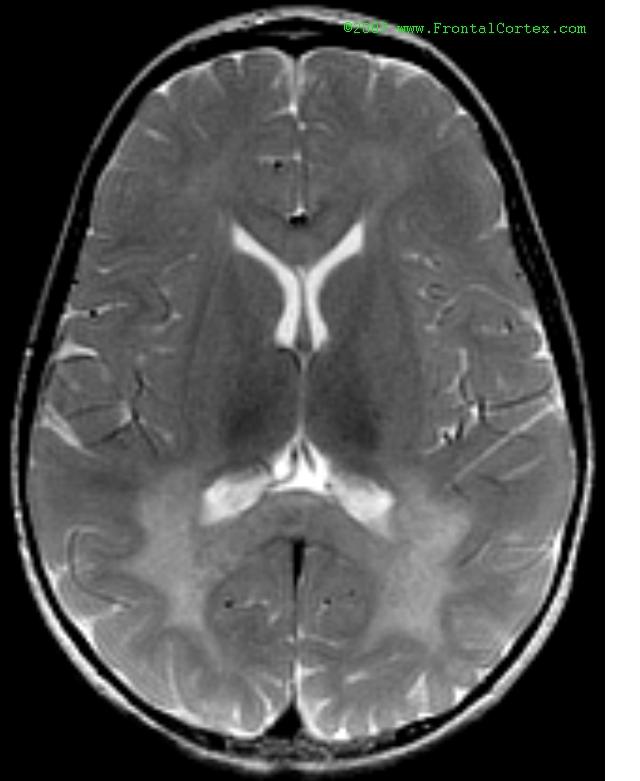Inborn Errors of Metabolism 03
Topic: Imaging
Created on Sunday, September 23 2007 by jdmiles
Last modified on Sunday, September 23 2007.
A 15 year-old female presents with complaints of weakness and progressive difficulties with walking. Physical exam reveals hypotonia and absent patellar and achilles reflexes. An MRI is obtained, and is shown above.
Of the following, which is the most likely diagnosis?
This question was created on September 23, 2007 by jdmiles.
This question was last modified on September 23, 2007.
ANSWERS AND EXPLANATIONS
A) Really big posterior circulation strokes
This answer is incorrect.
The imaging and history are not characteristic of a vascular etiology. The onset is progressive rather than sudden. The Imaging shows selective white matter invovlement, which would not be typical of a vascular etiology. (
See References)
|
 |  |  | 
|  |  |
| Please log in if you want to rate questions. |
B) Niemann-Pick disease
This answer is incorrect.
This kid's history and imaging are not characteristic of Niemann-Pick disease. (
See References)
|
 |  |  | 
|  |  |
| Please log in if you want to rate questions. |
C) Huntington chorea
This answer is incorrect.
This kid's history and imaging are not characteristic of Huntington chorea. (
See References)
|
 |  |  | 
|  |  |
| Please log in if you want to rate questions. |
D) Refsum disease
This answer is incorrect.
This kid's history and imaging are not characteristic of Refsum disease.
(
See References)
|
 |  |  | 
|  |  |
| Please log in if you want to rate questions. |
E) Metachromatic leukodystrophy
This answer is correct.
Metachromatic leukodystrophy is an inherited abnormality of myelin metabolism that affects both central and peripheral nervous systems. It results from a defect in the activity of the enzyme arylsulfatase-A, and the defect typically maps to chromosome 22q13. It is generally described as having 3 forms, depending on age of onset: late infantile, jvenile, and adult.
This child suffers from the juvenile onset form of metachromatic leukodystrophy. When the age of onset is between 3-16 years, the typical presentation is peripheral neuropathy manifested as progressive gait difficulty, areflexia in the lower extremities, hypotonia, and eventually emotional disturbance or dementia. MRI findings reveal a posterior leukoencephalopathy, as shown. EMG reveals slowed conduction velocities. LP may reveal increased protein.
(
See References)
|
 |  |  | 
|  |  |
| Please log in if you want to rate questions. |
References:
| 1. Bosch, E.P., and Smith, B.E. (2004). Disorders of peripheral nerves. In Bradley, W.G., Daroff, R.B., Fenichel, G.M., and Jankovic, J. (Eds.). Neurology in Clinical Practice, Fourth Edition. Butterworth Heinemann, Philadelphia, pp. 2299-2401.
| |
| 2. Rowland, L.P. (Ed) (2000). Merritt's Neurology, 10th Edition. Lippincott Williams & Wilkins, Philadelphia.
| |
|
 |  |  | 
|  |  |
| Please log in if you want to rate questions. |
FrontalCortex.com -- Neurology Review Questions -- Neurology Boards -- Board Review -- Residency Inservice Training Exam -- RITE Exam Review
imaging
Inborn Errors of Metabolism 03
Question ID: 091707022
Question written by J. Douglas Miles, (C) 2006-2009, all rights reserved.
Created: 09/23/2007
Modified: 09/23/2007
Estimated Permutations: 4200
























